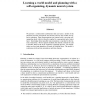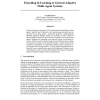NIPS
2003
14 years 2 months ago
2003
The relative depth of objects causes small shifts in the left and right retinal positions of these objects, called binocular disparity. Here, we describe a neuromorphic implementa...
NIPS
2003
14 years 2 months ago
2003
We present a connectionist architecture that can learn a model of the relations between perceptions and actions and use this model for behavior planning. State representations are...
NIPS
2003
14 years 2 months ago
2003
This paper presents an algorithm for learning the time-varying shape of a non-rigid 3D object from uncalibrated 2D tracking data. We model shape motion as a rigid component (rotat...
NIPS
2003
14 years 2 months ago
2003
Biochemical signal-transduction networks are the biological information-processing systems by which individual cells, from neurons to amoebae, perceive and respond to their chemic...
NIPS
2003
14 years 2 months ago
2003
Recent research has demonstrated that useful POMDP solutions do not require consideration of the entire belief space. We extend this idea with the notion of temporal abstraction. ...
NIPS
2003
14 years 2 months ago
2003
Recent multi-agent extensions of Q-Learning require knowledge of other agents’ payoffs and Q-functions, and assume game-theoretic play at all times by all other agents. This pap...
NIPS
2003
14 years 2 months ago
2003
We have constructed a second generation CPG chip capable of generating the necessary timing to control the leg of a walking machine. We demonstrate improvements over a previous ch...
NIPS
2003
14 years 2 months ago
2003
Many real-world domains are relational in nature, consisting of a set of objects related to each other in complex ways. This paper focuses on predicting the existence and the type...
NIPS
2003
14 years 2 months ago
2003
In typical classification tasks, we seek a function which assigns a label to a single object. Kernel-based approaches, such as support vector machines (SVMs), which maximize the ...
NIPS
2003
14 years 2 months ago
2003
This paper devises a novel kernel function for structured natural language data. In the field of Natural Language Processing, feature extraction consists of the following two ste...


